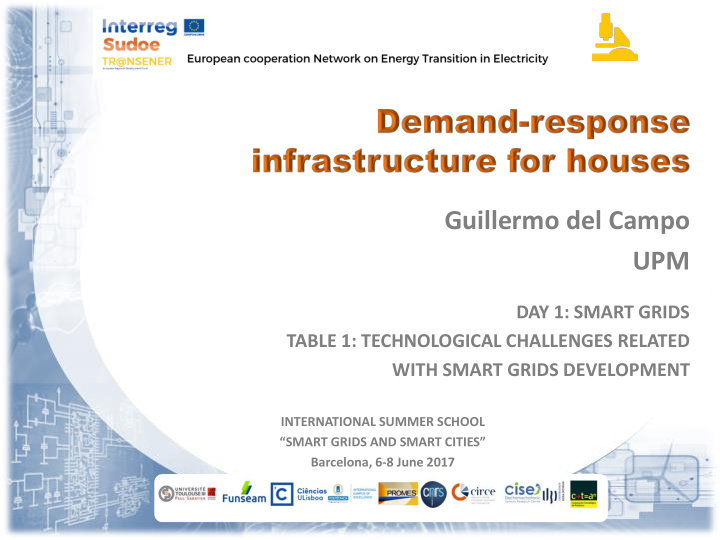



Guillermo del Campo UPM DAY 1: SMART GRIDS TABLE 1: TECHNOLOGICAL CHALLENGES RELATED WITH SMART GRIDS DEVELOPMENT INTERNATIONAL SUMMER SCHOOL “SMART GRIDS AND SMART CITIES” Barcelona, 6-8 June 2017
Context • Dramatic growth of energy demand. • Energy security requirement. • Increased use of renewable energies for electricity generation. • Uncertain and intermittent nature of renewable energy. • Balance between the supply and demand sides. • Imbalance: low efficiency, energy waste, blackout, etc. 2
Context • Grid interconnection into regional, national, or continent wide networks. • Large energy storage systems integration. • Energy demand side reduction: o Energy efficiency of electric loads improvement. o Flexible electric loads---demand-response. 3
• Residential sector: around 30 – 40% of global consumption. • Contribution to seasonal and daily peak demand. • Electrical power grid is over-dimensioned. • Utility companies generation increase. 4
“Changes in electric usage by end-use customers from their normal consumption patterns in response to changes in the price of electricity over time, or to incentive payments designed to induce lower electricity use at times of high wholesale market prices or when system reliability is jeopardized.” (U.S. Department of Energy, 2006) 5
Price-based (or implicit) DR • Dynamic electricity pricing. • High price during peak periods. • Participants change their usage. Mainly three types: • Time of Use (TOU). • Critical Peak Pricing (CPP). • Real-time Pricing (RTP). 6
Incentive-based (or explicit) DR • Incentives for reducing load at times. Classical schemes: • Direct Load Control. • Interruptible/curtailable rates. Market-based programs: • Demand bidding/buyback programs. • Emergency DR programs. • Capacity market programs. • Ancillary services market programs. 7
UTILITY SERVICE Home 1 Smart Meter PROVIDER . . . DR Controller AGGREGATOR . . Load 1 . . . Home N Load 1 8
Noncontrollable loads Reparameterizable loads Lighting HVAC Cooking appliances Refrigerators Interruptible loads Shiftable loads Washing machines HVAC Refrigerators Dishwashers 9
Shorts turn-off Expected during amount and peak demand time Automatic Temperature scheduling boundary adjustment 10
Shiftable loads • Internet connected appliances • Smart Plug interface Thermal regulation • Connected Thermostat Energy Monitoring • Smart Meter 11
Energy Generation Smart Devices Home Energy Ambient sensors Management Energy System Aggregator Smart Meter User interface 12
Coordinator JAVA Devices External Server HTTP <> CoAP CoAP TCP, UDP Application UDP IPv6 > IP HTTP, CoAP Internet IPv6/RPL IPv6 IPv6, IP TCP, UDP 6LoWPAN 6LoWPAN Ethernet, IP Wifi … IEEE IEEE 802.15.4 802.15.4 13
User interaction 14
Technical • New equipment required. • Lack of large suitable appliances. Customer • Benefit to consumers uncertain. Institutional • Different interests electricity supplier and DSO. • Not enough value to market players. Regulatory • Regulation obstructs the distribution system operator. 15
Guillermo del Campo e-mail: gcampo@cedint.upm.es Campus de Montegancedo sn 28223 Pozuelo de Alarcon Madrid, Spain Phone: +34914524900 ext. 1739 Fax: +34913364501 16
Recommend
More recommend